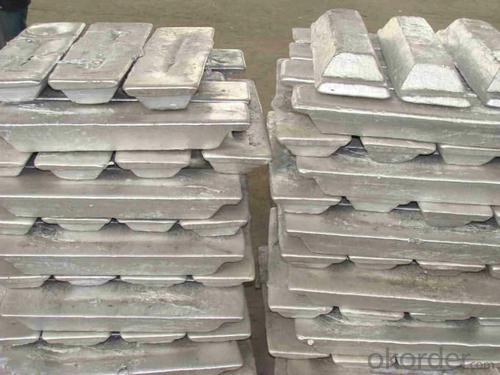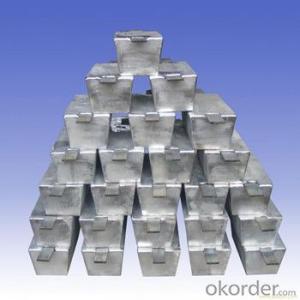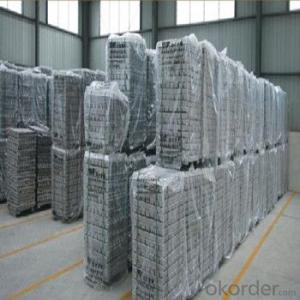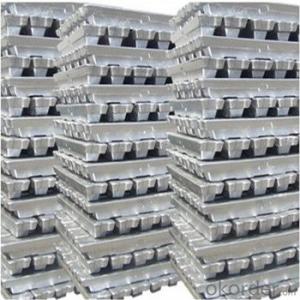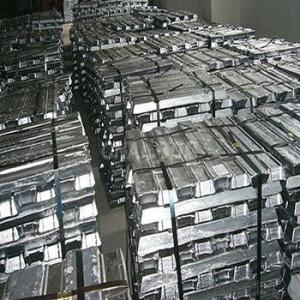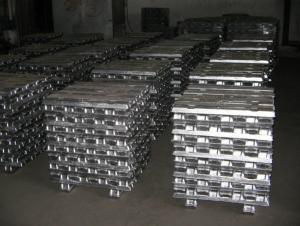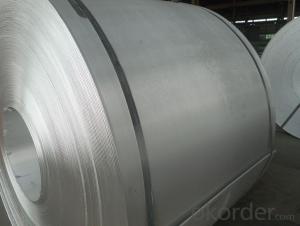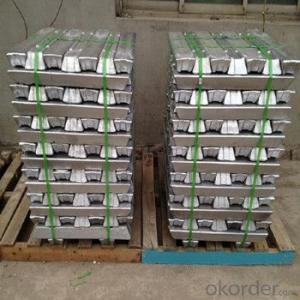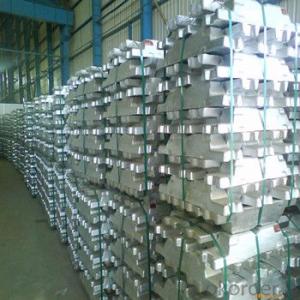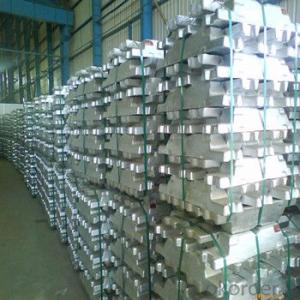Aluminum Ingots AA1060
- Loading Port:
- Shanghai
- Payment Terms:
- TT or LC
- Min Order Qty:
- 20 Tons m.t.
- Supply Capability:
- 1000 Sets Per Month m.t./month
OKorder Service Pledge
Quality Product, Order Online Tracking, Timely Delivery
OKorder Financial Service
Credit Rating, Credit Services, Credit Purchasing
You Might Also Like
1. Specifications of Aluminum Ingots AA1060
| Product Name | Aluminum Ingot |
| Chemical Composition | Al |
| Weight | 20/25kg |
| Al (Min) | 99%-99.9% |
| Appearance | silvery white |
| Advantages | easy control and operation, fast melting |
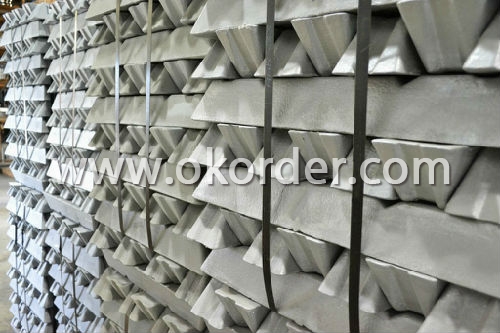
2. Usage/Application of Aluminum Ingots AA1060
A. mainly used for melting ingot
B. discontinuous melting with scrap
3.Packaging & Delivery of Aluminum Ingots AA1060
About 25Kg /Ingot, Packed in wooden case, Net weight 1000Kg/ Case, or as customer's requirements.
- Q: How are defects in aluminum ingots repaired?
- Defects in aluminum ingots can be repaired through various methods such as hot repairing, cold repairing, or by using specialized welding techniques. Hot repairing involves reheating the ingot to a specific temperature and applying pressure to eliminate any defects. Cold repairing, on the other hand, involves cutting out the defective sections and then welding or brazing new aluminum pieces in place. Welding techniques such as TIG (Tungsten Inert Gas) or MIG (Metal Inert Gas) welding can also be used to repair defects by melting and joining the aluminum surfaces. The specific repair method depends on the type and extent of the defect, as well as the desired quality of the final product.
- Q: What is the price of aluminum ingots in the market?
- The price of aluminum ingots in the market can vary depending on several factors such as supply and demand dynamics, global economic conditions, and market trends. As of my knowledge, the price of aluminum ingots typically ranges between $1,800 to $2,200 per metric ton. However, it is important to note that these prices are subject to change and may vary in different regions or at different times. For the most accurate and up-to-date information, it is advisable to consult reliable sources such as metal industry reports, commodity exchanges, or market analysts specializing in the aluminum sector.
- Q: What kind of aluminum consumption does the furnace compare with natural gas?
- Oil burning more intense flame, smelting time will be much shorter than natural gas, this is the car after the gas, power is much better than gasoline. The answer is obvious: the aluminum loss of gas will be greater.
- Q: The main raw material for aluminum smelting aluminum ingots from which into
- The raw materials used in smelting aluminium ingots from China's recycled aluminium plants mainly come from two aspects: first, scrap aluminium imported from abroad, and two domestic scrap aluminum.
- Q: Aluminum profile manufacturers which good? How to choose?
- Explain as follows: preparing goods, recruit a few operator, big online promotion can be opened. Those who are often hurt are our buyers. Miss wiring mostly do not know how to use, only know the unit price. How to use to meet customer needs; how to make the most cost-effective; in different venues that kind of connection is the best; these are they can not answer accurately. Only know the cheapest and recommended profile connection the cheapest; this connection is the lowest cost, but the cost of artificial, a connection is the weakest, aluminum convenience wouldn't be reflected, and will bring much trouble for the future reconstruction. But the wiring girl will push it one way.
- Q: How are aluminum ingots used in the production of automotive parts?
- Aluminum ingots are used in the production of automotive parts as they are melted and cast into specific shapes to create components such as engine blocks, cylinder heads, wheels, and transmission housings. The lightweight and high strength properties of aluminum make it an ideal material for improving fuel efficiency, enhancing performance, and reducing overall vehicle weight. These ingots are processed through various techniques like casting, forging, and machining to manufacture durable and efficient automotive parts.
- Q: How are aluminum ingots used in the production of doors and windows?
- Aluminum ingots are used in the production of doors and windows as they are melted down and shaped into extrusions, which are then used to create the frames and profiles of the doors and windows. These extrusions provide the structural strength, durability, and corrosion resistance necessary for high-quality door and window frames.
- Q: How can I make a pop top aluminum ingot?
- Production of miscellaneous aluminium ingots by mixing with other waste aluminum;A deoxidizer used in steelmaking;Production of aluminum: the waste cans in the rotary kiln for stripping paint processing, and then processing, production of low-grade aluminum powder.
- Q: What is the re ingot?Please give me a detailed explanation
- Aluminum ash. Aluminum ash is so the aluminum melting furnace burning, there are a small amount of aluminum ash burned, then turned into aluminum ash, is the aluminum ash to complex ingot businesses, and these businesses would put the ash in ash processing, put inside a small amount of aluminum by high temperature and then get out, this is some water for aluminum ingot casting into shape, so called multi spindle
- Q: How are aluminum ingots used in the production of aerospace components?
- Aluminum ingots are used in the production of aerospace components as they serve as the primary raw material for manufacturing various parts such as aircraft frames, fuselages, wings, and engine components. These ingots are melted and cast into specific shapes and sizes to create lightweight and durable components that meet the stringent requirements of the aerospace industry. The use of aluminum ingots allows for improved fuel efficiency, better performance, and increased payload capacity of aircraft, making them an essential material in aerospace manufacturing.
We are a well-known enterprise specializing in the production and sales of aluminum sheets and coils.
Since the establishment of us, we have been devoted to setting up a good CIS and completely implementing ISO9001 quality management system.
1. Manufacturer Overview
| Location | Henan,China |
| Year Established | 1993 |
| Annual Output Value | Above US$200 Million |
| Main Markets | Mid East;Eastern Europe;North America |
| Company Certifications | ISO 9001:2000;ISO 14001:2004;OHSAS 18001 |
2. Manufacturer Certificates
| a) Certification Name | |
| Range | |
| Reference | |
| Validity Period |
3. Manufacturer Capability
| a) Trade Capacity | |
| Nearest Port | Shanghai |
| Export Percentage | 30%-50% |
| No.of Employees in Trade Department | 21-50 People |
| Language Spoken: | English;Chinese |
| b) Factory Information | |
| Factory Size: | Above 100,000 square meters |
| No. of Production Lines | Above 10 |
| Contract Manufacturing | OEM Service Offered;Design Service Offered |
| Product Price Range | Average |
Send your message to us
Aluminum Ingots AA1060
- Loading Port:
- Shanghai
- Payment Terms:
- TT or LC
- Min Order Qty:
- 20 Tons m.t.
- Supply Capability:
- 1000 Sets Per Month m.t./month
OKorder Service Pledge
Quality Product, Order Online Tracking, Timely Delivery
OKorder Financial Service
Credit Rating, Credit Services, Credit Purchasing
Similar products
Hot products
Hot Searches
Related keywords




